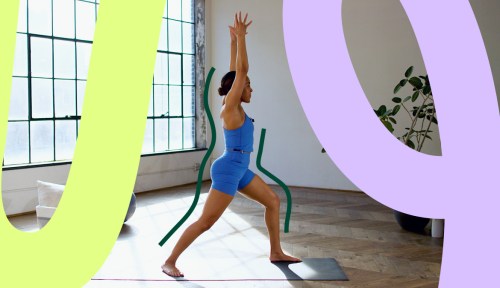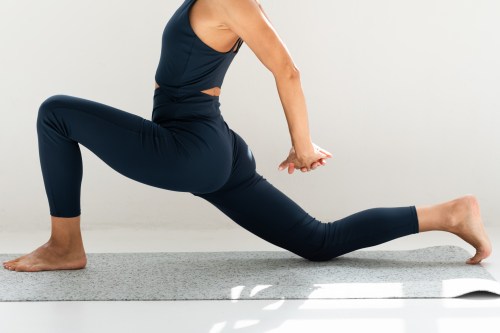Consider the following 6 foundational yoga poses like your favorite workout playlist: essential, easy to follow, and perfect for getting you in the groove. Before you start attempting headstands or pretzel-like twists, nailing the basics helps prevent injury, enhances the mind-body connection, and makes the practice accessible to everyone, regardless of age or ability level.
Experts in This Article
certified yoga instructor and founder of Undone, a pop-up yoga experience
“Foundational yoga poses are simple yet powerful,” says Paige Willis, RYT-200, certified yoga instructor and founder of Undone, a pop-up yoga experience.
“They allow seasoned and new practitioners to befriend their bodies and how they’re showing up that day. Coming back to foundational poses often is the maintenance work that reminds us how far we’ve come and grounds us in where we want to go.”
For April 2024, we’ve asked Willis to host our Movement of the Month Club, focusing on yoga. For Week 1, she’s selected the 6 foundational yoga poses below—including mountain pose, forward fold, downward facing dog, and warrior I. These are the building blocks of your yoga practice, setting the stage for all the other poses you’ll do later on.
Follow along with her as she guides you through this approach to create a sustainable practice that promotes physical and mental well-being, allowing you to progress safely and enjoyably while reaping the long-term benefits of yoga.
Join the Movement
If you’re following along with our Movement of the Month Club, you’ll do one pose each day, Monday through Saturday. Then on Sunday, you’ll do the full 5-minute routine.
Do each of these 6 foundational yoga poses for 50 seconds (25 seconds on each side, where necessary) before moving on to the next one, for a total of 5 minutes. If you’re feeling especially tight or if you have more time, feel free to do each move for as long as feels good.
1. Mountain Pose to Extended Mountain Pose (Tadasana)
Though this pose looks like “just standing,” it can be one of the hardest poses to master if you’re truly focusing on each part of your body, feet to head. But getting it right helps ground and lengthen your body, fostering a sense of balance and stability and promoting awareness of your breath and body.
- 1.Stand tall with your feet hip-width apart, arms relaxed by your sides, and palms facing forward.
- 2.Engage your quadriceps (front of thighs), lift your kneecaps, and tuck your tailbone slightly under to engage your core.
- 3.Roll your shoulders back and down, opening your chest.
- 4.Lengthen your spine by reaching the crown of your head toward the ceiling without straining.
- 5.Take a few deep breaths here, grounding down through all 10 toes and the heels of your feet.
- 6.As you inhale, lift your arms out to the sides and up overhead, reaching toward the sky.
- 7.Keep your palms facing each other or press them together overhead, depending on your mobility.
- 8.Keep your gaze forward or lift it gently toward your hands if it doesn’t strain your neck.
2. Forward Fold to Halfway Lift (Uttanasana to Ardha Uttanasana)
This pair of poses gently stretches your hamstrings (beneficial for those who spend time sitting down) and helps balance and decompress your spine, which can help improve your posture over time.
- 1.Begin standing in mountain pose (see above).
- 2.Exhale as you hinge forward at your hips, bending from your waist and folding your torso over your thighs.
- 3.Let your head hang heavy and relax your neck, allowing your arms to dangle toward the floor.
- 4.If possible, bring your palms or fingertips to the floor beside your feet. If your flexibility is limited, you can bend your knees slightly to make this more accessible. Feel the stretch along the back of your legs and spine as you surrender into the pose.
- 5.On an inhale, press your palms or fingertips into the floor or your shins or thighs (depending on your flexibility) and lift your torso halfway up.
- 6.Lengthen your spine forward, reaching your crown away from your tailbone and creating a straight line from your head to your tailbone. Keep your spine long and flat, engaging your core to support your lower back.
- 7.Keep your gaze slightly forward to maintain a neutral neck.
3. High Plank to Low Plank (Chaturanga)
These two plank variations help build strength in your core, arms, chest, back, and shoulders, while promoting wrist strength and mobility.
- 1.Begin at the top of a push-up position with your hands beneath your shoulders, and your body in a straight line from your head to your heels.
- 2.Engage your core to keep your hips in line with the rest of your body. Keep your gaze slightly forward to maintain a neutral neck.
- 3.On an exhale, lower your body toward the ground by bending your elbows directly back alongside your ribcage.
- 4.To release, you can either lower all the way down to the ground, transition into upward facing dog (see below) or press back up to high plank.
4. Upward Facing Dog (Urdhva Mukha Svanasana)
A deep backbend and heart-opening pose, upward facing dog helps improve blood circulation, stretches the front of your body, and strengthens the back of your body. Opening your chest also helps counteract the effects of sitting for long periods of time.
- 1.Lie on your belly with your palms planted firmly on the ground beneath your shoulders. Roll your shoulders back and down, opening your chest.
- 2.Press firmly into the tops of your feet and engage your leg muscles to lift your knees off the ground. Simultaneously straighten your arms, lifting your chest and torso off the ground.
- 3.Roll onto the tops of your feet, pressing down through your toes to lift the front of your body higher.
- 4.Extend through your arms, lifting your chest up and forward, while simultaneously drawing your shoulder blades down and back.
5. Downward Facing Dog (Adho Mukha Svanasana)
This pose is a gentle inversion, where your head is below your heart, which helps calm your nervous system. It also helps stretch and decompress your spine, which may help relieve mild back pain.
- 1.Begin on your hands and knees in a tabletop position, with your wrists under your shoulders and your knees under your hips.
- 2.On an exhale, tuck your toes under and lift your hips up toward the ceiling, straightening your arms and legs.
- 3.Press down through your palms and fingertips as you lift your hips high.
- 4.Engage your quadriceps (front of the thigh) to lift your kneecaps and lengthen through your legs.
- 5.Allow your heels to sink toward the floor, but don’t worry if they don’t touch—focus on creating length in your spine and legs.
- 6.Keep a slight bend in your knees if you feel any strain in your hamstrings or lower back.
6. Warrior 1 (Virabhadrasana 1)
The last of our six foundational yoga poses, warrior I strengthens the muscles in your legs (quadriceps, hamstrings, and calves), while stretching your hips flexors. It also promotes an overall sense of balance and stability as you ground through the four corners of each foot and lift your torso up and out of your hips.
- 1.Begin in downward facing dog. From here, step your right foot forward between your hands, placing it near the right thumb.
- 2.Ground down through the outer edge of your left foot, keeping it at about a 45-degree angle.
- 3.On an inhale, rise up, lifting your torso and arms overhead.
- 4.Bend your right knee, stacking it over your right ankle. Aim for a 90-degree angle with your front leg.
- 5.Keep your left leg straight and strong, pressing into the outer edge of your foot to stabilize your stance.
- 6.Square your hips toward the front of the mat, drawing the left hip forward and the right hip back.
Sign Up for Our Daily Newsletter
Get all the latest in wellness, trends, food, fitness, beauty, and more delivered right to your inbox.
Got it, you've been added to our email list.











